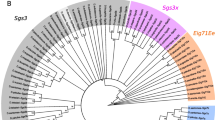Abstract
The human cancer susceptibility gene, BRCA2, functions in double-strand break repair by homologous recombination, and it appears to function via interaction of a repetitive region (“BRC repeats”) with RAD-51. A putatively simpler homolog, dmbrca2, was identified in Drosophila melanogaster recently and also affects mitotic and meiotic double-strand break repair. In this study, we examined patterns of repeat variation both within Drosophila pseudoobscura and among available Drosophila genome sequences. We identified extensive variation within and among closely related Drosophila species in BRC repeat number, to the extent that variation within this genus recapitulates the extent of variation found across the entire animal kingdom. We describe patterns of evolution across species by documenting recent repeat expansions (sometimes in tandem arrays) and homogenizations within available genome sequences. Overall, we have documented patterns and modes of evolution in a new model system of a gene which is important to human health.


Similar content being viewed by others
References
Barnwell CV, Kommaraju KR, Noor MAF (2008) Disruption of Drosophila melanogaster dmbrca2 (CG30169) affects rates of female meiotic crossing over. Drosoph Inf Serv 91:1–4
Bork P, Blomberg N, Nilges M (1996) Internal repeats in the BRCA2 protein sequence. Nat Genet 13:22–23
Brough R, Wei D, Leulier S et al (2008) Functional analysis of Drosophila melanogaster BRCA2 in DNA repair. DNA Repair 7:10–19
Clark AG, Eisen MB, Smith DR et al (2007) Evolution of genes and genomes on the Drosophila phylogeny. Nature 450:203–218
Fay JC, Wu CI (2000) Hitchhiking under positive Darwinian selection. Genetics 155:1405–1413
Fitch WM, Margoliash E (1967) Construction of phylogenetic trees. Science 155:279–284
Fu YX, Li WH (1993) Statistical tests of neutrality of mutations. Genetics 133:693–709
Gerton JL, Hawley RS (2005) Homologous chromosome interactions in meiosis: diversity amidst conservation. Nat Rev Genet 6:477–488
Gloor GB, Engels WR (1992) Single-fly DNA preps for PCR. Drosoph Inf Serv 71:148–149
Goldstein DB, Linares AR, Cavalli-Sforza LL, Feldman MW (1995) An evaluation of genetic distances for use with microsatellite loci. Genetics 139:463–471
Gudmundsdottir K, Ashworth A (2006) The roles of BRCA1 and BRCA2 and associated proteins in the maintenance of genomic stability. Oncogene 25:5864–5874
Hall TA (1994) BioEdit: a user-friendly biological sequence alignment editor and analysis program for Windows 95/98/NT. Nucl Acids Symp Ser 41:95–98
Hartley CL, McCulloch R (2008) Trypanosoma brucei BRCA2 acts in antigenic variation and has undergone a recent expansion in BRC repeat number that is important during homologous recombination. Mol Microbiol 68:1237–1251
Klovstad M, Abdu U, Schupbach T (2008) Drosophila brca2 is required for mitotic and meiotic DNA repair and efficient activation of the meiotic recombination checkpoint. PLoS Genet 4:e31
Kong A, Thorleifsson G, Stefansson H et al (2008) Sequence variants in the RNF212 gene associate with genome-wide recombination rate. Science 319:1398–1401
Legendre M, Pochet N, Pak T, Verstrepen KJ (2007) Sequence-based estimation of minisatellite and microsatellite repeat variability. Genome Res 17:1787–1796
Li W, Ma H (2006) Double-stranded DNA breaks and gene functions in recombination and meiosis. Cell Res 16:401–412
Lo T, Pellegrini L, Venkitaraman AR, Blundell TL (2003) Sequence fingerprints in BRCA2 and RAD51: implications for DNA repair and cancer. DNA Repair 2:1015–1028
Machado CA, Haselkorn TS, Noor MAF (2007) Evaluation of the genomic extent of effects of fixed inversion differences on intraspecific variation and interspecific gene flow in Drosophila pseudoobscura and D. persimilis. Genetics 175:1289–1306
McDonald JH, Kreitman M (1991) Adaptive protein evolution at the Adh locus in Drosophila. Nature 351:652–654
Nagaraju G, Scully R (2007) Minding the gap: the underground functions of BRCA1 and BRCA2 at stalled replication forks. DNA Repair (Amst) 6:1018–1031
Peixoto AA, Costa R, Wheeler DA, Hall JC, Kyriacou CP (1992) Evolution of the threonine-glycine repeat region of the period gene in the melanogaster species subgroup of Drosophila. J Mol Evol 35:411–419
Pellegrini L, Venkitaraman A (2004) Emerging functions of BRCA2 in DNA recombination. Trends Biochem Sci 29:310–316
Pellegrini L, Yu DS, Lo T et al (2002) Insights into DNA recombination from the structure of a RAD51-BRCA2 complex. Nature 420:287–293
Richards S, Liu Y, Bettencourt BR et al (2005) Comparative genome sequencing of Drosophila pseudoobscura: chromosomal, gene, and cis-element evolution. Genome Res 15:1–18
Rozas J, Sanchez-DelBarrio JC, Messeguer X, Rozas R (2003) DnaSP, DNA polymorphism analyses by the coalescent and other methods. Bioinformatics 19:2496–2497
Shivji MK, Davies OR, Savill JM et al (2006) A region of human BRCA2 containing multiple BRC repeats promotes RAD51-mediated strand exchange. Nucleic Acids Res 34:4000–4011
Tajima F (1989) Statistical method for testing the neutral mutation hypothesis by DNA polymorphism. Genetics 123:585–595
Valdes AM, Slatkin M, Freimer NB (1993) Allele frequencies at microsatellite loci: the stepwise mutation model revisited. Genetics 133:737–749
Venkitaraman AR (2002) Cancer susceptibility and the functions of BRCA1 and BRCA2. Cell 108:171–182
Wierdl M, Dominska M, Petes TD (1997) Microsatellite instability in yeast: dependence on the length of the microsatellite. Genetics 146:769–779
Xia F, Taghian DG, DeFrank JS et al (2001) Deficiency of human BRCA2 leads to impaired homologous recombination but maintains normal nonhomologous end joining. Proc Natl Acad Sci USA 98:8644–8649
Acknowledgments
The authors thank Callie Barnwell and Lisa Bukovnik (IGSP sequencing center) for technical assistance. Funding was provided by a Research Experience for Undergraduates (REU) supplement from the National Science Foundation (to award 0509780) as well as NSF grant 0715484 and NIH grant GM076051.
Author information
Authors and Affiliations
Corresponding author
Electronic supplementary material
Rights and permissions
About this article
Cite this article
Bennett, S.M., Noor, M.A.F. Molecular evolution of a Drosophila homolog of human BRCA2 . Genetica 137, 213–219 (2009). https://doi.org/10.1007/s10709-009-9376-9
Received:
Accepted:
Published:
Issue Date:
DOI: https://doi.org/10.1007/s10709-009-9376-9




